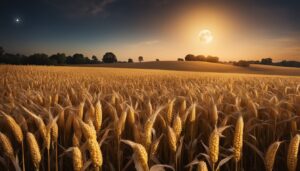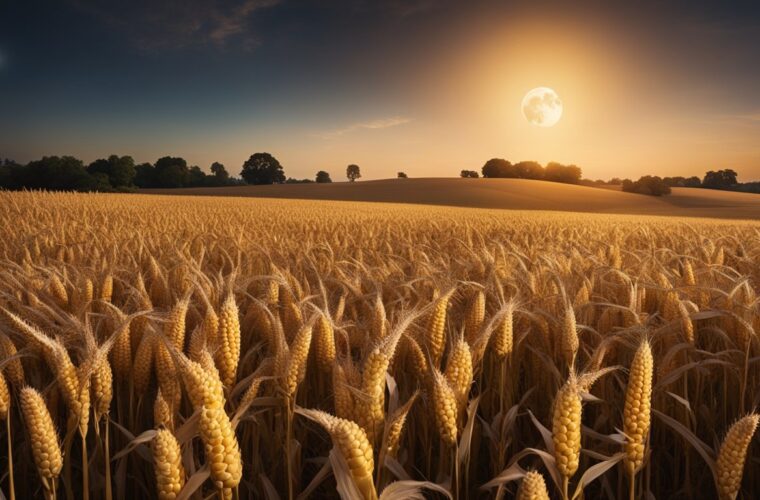Are you curious about the meaning behind the Corn Moon? This is the name given to the full moon that occurs in September, and it holds a significant place in various cultures and traditions. The name “Corn Moon” comes from the Native American tradition, where it represents the time when corn is harvested.
In some cultures, it is also known as the Harvest Moon. This is because it is the full moon closest to the autumnal equinox, which marks the beginning of fall. The Harvest Moon is a time to give thanks for the abundance of food and resources that the earth has provided. It is a time to celebrate the harvest and to prepare for the coming winter months.

The Corn Moon holds a special place in many cultures and traditions. Its significance goes beyond just being a full moon in September. Whether you are interested in its spiritual or cultural significance, or simply want to learn more about this fascinating celestial event, read on to discover the meaning behind this special full moon.
Origins of the Corn Moon
This is a name given to the full moon that appears in August or September. It is known by many other names such as the Barley Moon, Harvest Moon, and Grain Moon. The name Corn Moon originated from the Native American tribes that used it as a reference to the time for harvesting corn.
According to Native American folklore, this is a time of abundance and prosperity. It is a time to celebrate the harvest and give thanks for the bountiful crops. During this time, the corn is at its ripest and ready to be harvested. The harvest of corn was a crucial event for Native American tribes as it provided them with food for the winter months.
The Corn Moon also holds spiritual significance for many Native American tribes. It is believed that during this time, the spirits of the ancestors return to earth to help with the harvest. It is therefore a time for reflection and gratitude for the blessings of the harvest and the guidance of the ancestors.
In addition to Native American folklore, it has also been associated with other cultures and traditions. For example, in some European cultures, the Corn Moon is known as the Harvest Moon and is associated with the end of the summer harvest season.
Overall, this is a time to celebrate the abundance of the harvest and give thanks for the blessings of the earth. It is a time to reflect on the past and look forward to the future with hope and gratitude.
Cultural Significance
This Moon, also known as the Harvest Moon, occurs in September and is named after the time of year when corn is harvested. It holds cultural significance in various traditions around the world. In this section, we will explore the Native American traditions and agricultural importance of the Corn Moon.
Native American Traditions
Native American tribes have their own unique names for each full moon of the year, including the Corn Moon. According to the Eastern Trail, it is also called the Barley Moon because it is the time to harvest and thresh the ripened barley. Other names for this moon include the Green Corn Moon and the Full Corn Moon.
For many Native American tribes, it represents a time of abundance and gratitude. It is a time to give thanks for the harvest and to honor the Earth’s bounty. Some tribes hold corn festivals during this time, where they share food and celebrate the harvest with dances and ceremonies.
Agricultural Importance
The Corn Moon is an important time for farmers as it marks the end of the growing season and the beginning of the harvest. It is a time to reap the rewards of hard work and to gather the crops before the onset of winter. According to Learn Religions, some of the many deities of this season are Vulcan, Mars, Hathor, and Thoth.
In addition to corn, other crops that are typically harvested during this time include barley, wheat, and oats. The Corn Moon is also associated with the end of the summer season and the beginning of fall, making it a time of transition and change.
Overall, the Corn Moon is a time to celebrate the abundance of the harvest and to give thanks for the blessings of the Earth. Whether you are a farmer, a nature lover, or simply someone who appreciates the beauty of the full moon, the Corn Moon is a special time that holds deep cultural significance.
Astronomical Context of the Corn Moon
The Corn Moon, also known as the Harvest Moon, is a full moon that occurs in September every year. It is named after the corn harvest season, which typically takes place during this time in the Northern Hemisphere.
During this time, the moon appears larger and brighter than usual due to its close proximity to the Earth. This phenomenon is known as the “moon illusion,” where the moon appears larger when it is near the horizon.
The Corn Moon also has astronomical significance. It marks the beginning of the autumnal equinox, which occurs when the sun is directly above the equator, resulting in equal amounts of daylight and darkness. This marks the transition from summer to fall in the Northern Hemisphere.
The Corn Moon is also known as the “Barley Moon” in some cultures, as it coincides with the barley harvest season. In addition, it is called the “Chrysanthemum Moon” in Japan, where the chrysanthemum flower is celebrated during this time.
Overall, the Corn Moon is a beautiful and significant astronomical event that has been celebrated by cultures around the world for centuries. Its significance in marking the changing of the seasons and the harvest season makes it an important event in many cultures.




